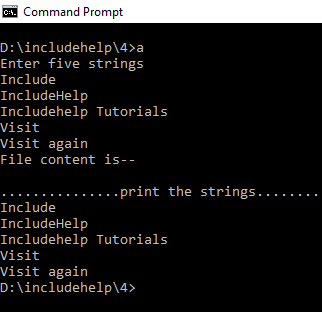C 中的 fgetpos() 函数
原型:
int fgetpos(FILE* filename, fpos_t *position);
参数:
FILE* filename, fpos_t *position,
返回类型:int(文件指示器指针的当前位置)
函数的使用:
在文件处理中,通过fgetpos()函数我们得到输入文件流指示器的当前位置。每当我们需要文件中的文件指示器位置时,我们需要使用函数 fgetpos()。 fgetpos()函数的原型是:int fgetpos(FILE* filename, fpos_t *position);
这里的数据类型position变量必须是fpos_t类型。
C 中的 fgetpos() 示例
#include <stdio.h>
#include <stdlib.h>
int main()
{
FILE* f;
char ch[100];
//Initialize the position variable
fpos_t pos;
//Create the file for write operation
f = fopen("includehelp.txt", "w+");
//Store the value of the function point indicator
fgetpos(f, &pos);
printf("Enter five strings\n");
for (int i = 0; i < 4; i++) {
//take the strings from the users
scanf("%[^\n]", &ch);
//write back to the file
fputs(ch, f);
//every time take a new line for the new entry string
//except for last entry.Otherwise print the last line twice
fputs("\n", f);
//clear the stdin stream buffer
//if we don't write this then after taking string
//%[^\n] is waiting for the '\n' or white space
fflush(stdin);
}
//take the strings from the users
scanf("%[^\n]", &ch);
fputs(ch, f);
//set the indicator position to the initial position of the file
fsetpos(f, &pos);
printf("File content is--\n");
printf("\n...............print the strings..............\n\n");
while (!feof(f)) {
//takes the first 100 character in the character array
fgets(ch, 100, f);
//and print the strings
printf("%s", ch);
}
//close the file
fclose(f);
return 0;
}输出

相关用法
- C语言 fgets()用法及代码示例
- C语言 fgetc()用法及代码示例
- C语言 fgets() and gets()用法及代码示例
- C语言 fgetc() and fputc()用法及代码示例
- C语言 fread()用法及代码示例
- C语言 feof()用法及代码示例
- C语言 fillellipse()用法及代码示例
- C语言 freopen()用法及代码示例
- C语言 frexp()用法及代码示例
- C语言 fclose()用法及代码示例
- C语言 fseek() vs rewind()用法及代码示例
- C语言 fflush()用法及代码示例
- C语言 fputc()用法及代码示例
- C语言 fputs()用法及代码示例
- C语言 fillpoly()用法及代码示例
- C语言 ftell()用法及代码示例
- C语言 fseek()用法及代码示例
- C语言 fscanf()用法及代码示例
- C语言 ferror()用法及代码示例
- C语言 fwrite()用法及代码示例
注:本文由纯净天空筛选整理自Souvik Saha大神的英文原创作品 fgetpos() function in C language with Example。非经特殊声明,原始代码版权归原作者所有,本译文未经允许或授权,请勿转载或复制。
